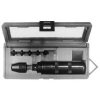Kurt S.
Member
How do I get screws out that have been put with a liberal dosage of loctite? I am trying to change out the scope and mount on my Marlin .45-70 and I think the folks that mounted it must have used a lot of the stuff or something like it on the screws. I got the scope off okay (FYI, the rings are integral with the mount) but boy-howdy those screws holding the mount on the reciever are in there good. They are Torx heads and I have actually broken off the tips of not one but two drivers! I think I can get the broken tips out, though.
A solution that doesn't involve drills and retapping screw holes would be good if anybody has one.
A solution that doesn't involve drills and retapping screw holes would be good if anybody has one.


